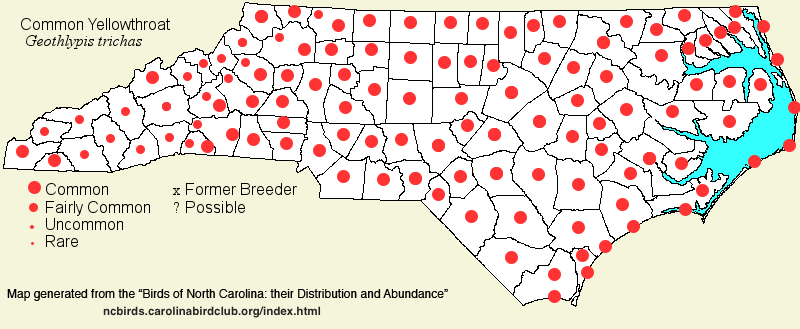 |  |
|
Common Yellowthroat - Geothlypis trichas PARULIDAE Members: | Search Common: Search Scientific: |
|
|
|||||||
| General Comments | This is the most widespread breeding warbler in the country, nesting across most of Canada and the United States, and wintering in the southern states. Not only does it have a wide breeding range, it is a common and easily found bird, and thus is certainly one of the two or three most abundant warblers on the continent. They breed in all 100 counties and winter across the Coastal Plain, and sparingly into the eastern and southern Piedmont. For breeding, yellowthroats occur in freshwater to slightly brackish marshes, wet thickets, overgrown fields, brier patches, woodland borders, and other dense herbaceous and shrubby growth -- usually where moist. Winter habitat is similar, but they tend to retreat to moist habitats (marshes and wet thickets), and are not often found in dry thickets. Though they occupy dense thickets, yellowthroats are quite inquisitive and come readily to squeaking and pishing. | ||||||
| Breeding Status | Breeder | ||||||
| NC BRC List | Definitive | ||||||
| State Status | |||||||
| U.S. Status | |||||||
| State Rank | S5B,S4N | ||||||
| Global Rank | G5 | ||||||
| Coastal Plain | Permanent resident, with migratory movements. In summer, common and very widespread across the province, including the Outer Banks. In winter, noticeably less common than in summer; fairly common in the southern and coastal parts of the region, including much of Tidewater (at least north to Lake Mattamuskeet); uncommon in the inner half and northern parts of the region (roughly, the northwestern half of the region). After severe winter weather, can be uncommon throughout. Peak counts: | ||||||
| Piedmont | Summer resident, and sparse winter resident in parts of the region. In summer, common and widespread, though slightly less numerous in and near foothill ranges. In winter, uncommon in early winter in the eastern and southern portions of the province, decreasing to rather rare to rare by midwinter; small numbers probably do overwinter. Farther inland, mainly a rare lingerer into early winter, but nearly gone by midwinter. Mainly late Mar to early winter; no obvious "departure dates". Peak counts: | ||||||
| Mountains | Summer resident; sparse into early winter. In summer, fairly common to common over the entire region, at least up to at least 5,500 feet, and rarely even higher. In winter, rare in the lower elevations in the southern areas, into Dec, but very rare by midwinter, and not likely overwintering. Very rare into early winter elsewhere. Most significant was one that overwintered, in the northern mountains (no less), as photographed on numerous dates at Brookshire Park (Watauga), 26 Dec 2016 - 5 Mar 2017. Mainly late Mar to late Oct. Peak counts: | ||||||
| Finding Tips |
No finding tips needed. **** | ||||||
| Attribution | LeGrand[2023-04-03], LeGrand[2017-08-23], LeGrand[2012-10-03] | ||||||
| NC Map Map depicts all counties with a report (transient or resident) for the species. | Click on county for list of all known species. |
| NC Breeding Season Map Map depicts assumed breeding season abundance for the species. |  |